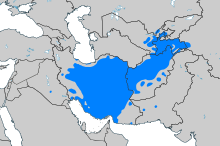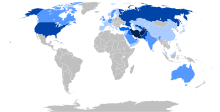Persian language
| Persian | |
|---|---|
| فارسی (fārsi), форсӣ (forsī) | |
 Fārsi written in Persian calligraphy (Nastaʿlīq) | |
| Pronunciation | [fɒːɾˈsiː] ( |
| Native to |
|
Native speakers | 70 million[7] (110 million total speakers)[6] |
Indo-European
| |
Early forms | Old Persian
|
Standard forms | |
| Dialects | |
| Official status | |
Official language in |
|
| Regulated by |
|
| Language codes | |
| ISO 639-1 | fa |
| ISO 639-2 | per (B) fas (T) |
| ISO 639-3 | fas – inclusive codeIndividual codes: pes – Iranian Persianprs – Daritgk – Tajik languageaiq – Aimaq dialectbhh – Bukhori dialecthaz – Hazaragi dialectjpr – Judeo-Persianphv – Pahlavanideh – Dehwarijdt – Judeo-Tatttt – Caucasian Tat |
| Glottolog | fars1254 |
| Linguasphere | |
 Areas with significant numbers of people whose first language is Persian (including dialects) | |
 Persian Linguasphere. Legend Official language
More than 1,000,000 speakers
Between 500,000 – 1,000,000 speakers
Between 100,000 – 500,000 speakers
Between 25,000 – 100,000 speakers
Fewer than 25,000 speakers / none | |
Persian (/ˈpɜːrʒən, -ʃən/), also known by its endonym Farsi (فارسی, Fārsī, [fɒːɾˈsiː] (![]() listen)), is a Western Iranian language belonging to the Iranian branch of the Indo-Iranian subdivision of the Indo-European languages. Persian is a pluricentric language predominantly spoken and used officially within Iran, Afghanistan and Tajikistan in three mutually intelligible standard varieties, namely Iranian Persian, Dari[10] and Tajik.[11] It is also spoken natively in the Tajik variety by a significant population within Uzbekistan,[12][13][14] as well as within other regions with a Persianate history in the cultural sphere of Greater Iran. It is written officially within Iran and Afghanistan in the Persian alphabet, a derivation of the Arabic script, and within Tajikistan in the Tajik alphabet, a derivation of the Cyrillic script.
listen)), is a Western Iranian language belonging to the Iranian branch of the Indo-Iranian subdivision of the Indo-European languages. Persian is a pluricentric language predominantly spoken and used officially within Iran, Afghanistan and Tajikistan in three mutually intelligible standard varieties, namely Iranian Persian, Dari[10] and Tajik.[11] It is also spoken natively in the Tajik variety by a significant population within Uzbekistan,[12][13][14] as well as within other regions with a Persianate history in the cultural sphere of Greater Iran. It is written officially within Iran and Afghanistan in the Persian alphabet, a derivation of the Arabic script, and within Tajikistan in the Tajik alphabet, a derivation of the Cyrillic script.
Modern Persian is a continuation of Middle Persian, an official language of the Sasanian Empire (224–651 CE), itself a continuation of Old Persian, which was used in the Achaemenid Empire (550–330 BCE).[15][16] It originated in the region of Fars (Persia) in southwestern Iran.[17] Its grammar is similar to that of many European languages.[18]
Throughout history, Persian was used as a prestigious language by various empires centered in Western Asia, Central Asia, and South Asia.[19] Old Persian is attested in Old Persian cuneiform on inscriptions from between the 6th and 4th century BC. Middle Persian is attested in Aramaic-derived scripts (Pahlavi and Manichaean) on inscriptions and in Zoroastrian and Manichaean scriptures from between the third to the tenth centuries (See Middle Persian literature). New Persian literature was first recorded in the ninth century, after the Muslim conquest of Persia, since then adopting the Arabic script.[20]
Persian was the first language to break through the monopoly of Arabic on writing in the Muslim world, with Persian poetry becoming a tradition in many eastern courts.[19] It was used officially as a language of bureaucracy even by non-native speakers, such as the Ottomans in Anatolia,[21] the Mughals in South Asia, and the Pashtuns in Afghanistan. It influenced languages spoken in neighboring regions and beyond, including other Iranian languages, the Turkic languages, Armenian, Georgian, and the Indo-Aryan languages. It also exerted some influence on Arabic,[22] while borrowing a lot of vocabulary from it in the Middle Ages.[15][18][23][24][25][26]
Some of the famous works of Persian literature from the Middle Ages are the Shahnameh of Ferdowsi, the works of Rumi, the Rubaiyat of Omar Khayyam, the Panj Ganj of Nizami Ganjavi, The Divān of Hafez, The Conference of the Birds by Attar of Nishapur, and the miscellanea of Gulistan and Bustan by Saadi Shirazi. Some of the prominent modern Persian poets were Nima Yooshij, Ahmad Shamlou, Simin Behbahani, Sohrab Sepehri, Rahi Mo'ayyeri, Mehdi Akhavan-Sales, and Forugh Farrokhzad.
There are approximately 110 million Persian speakers worldwide, including Persians, Tajiks, Hazaras, Caucasian Tats and Aimaqs. The term Persophone might also be used to refer to a speaker of Persian.[27][28]
Classification[]
Persian is a member of the Western Iranian group of the Iranian languages, which make up a branch of the Indo-European languages in their Indo-Iranian subdivision. The Western Iranian languages themselves are divided into two subgroups: Southwestern Iranian languages, of which Persian is the most widely spoken, and Northwestern Iranian languages, of which Kurdish is the most widely spoken.[29]
Name[]
The term Persian is an English derivation of Latin Persiānus, the adjectival form of Persia, itself deriving from Greek Persís (Περσίς),[30] a Hellenized form of Old Persian Pārsa (